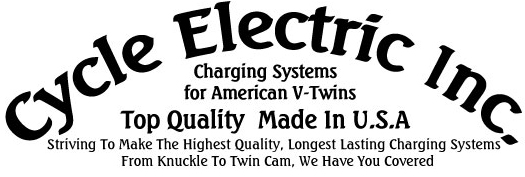

Over the years Harley Davidson has used many different alternator systems. They are usually designated by amperage out put such as a 22- amp or a
32-amp system. Until recently the easiest way to tell the systems apart
is by looking at the plugs that connect the stator to the regulator. Since
many of these systems can be interchanged sometimes people use a different
system when replacing them. If you are only replacing one or two of the
components it is important to look at the plug to determine which system
is actually in the bike. If in doubt change the stator, rotor and regulator
as a set. To figure out which system you have you can go to www.cycleelectricinc.com
and go to either the Rectifying regulator page or the stator page. If you
scroll down you will find pictures of the different plug types.
There are many different ways to test the alternator system. At the factory we have custom made testing equipment to test each component
separately. Without this special equipment it is difficult to test a stator,
rotor or regulator on the bench. I have two simple tests to check out the
stator and rotor combination on the bike. If the stator and rotor test
out good the regulator can be tested. The best way to test a regulator
is to hook it up to a known working stator and rotor combination. The motor
needs to be running to perform these tests so you need to do them before
disassembly.
Stators are very simple and their problems fall into two categories: shorts
and opens.
A short circuit occurs when one of the wires in the windings or the lead
wire make an electrical connection some place they should not. Shorts can
be from winding to winding or from winding to ground. An open circuit occurs
if a wire breaks.
Winding to winding shorts or opens will cause low stator voltage.
Rotor problems are relatively rare on stock motors. Motors with performance
modification that tend to run at a higher RPM range see more rotor problems.
These problems can include a striped spline, broken magnets and even a
broken rotor shell. All these problems will result in low stator voltage
Testing AC stator voltage
The object of this test is to see if the stator can produce proper AC voltage
per 1000 RPM. For example a 32-amp stator should put out 18 volts AC (VAC)
per each 1000-RPM. At 2000 it should be 36 VAC (18x2). At 3000 RPM it should
be 54 VAC (18 X 3).
Each system has a certain voltage it should produce per 1000 RPM.
The following is a list of the most common systems.
22 amp single phase = 24 VAC @ 1000 rpm
32 amp single phase = 18 VAC @ 1000 rpm
38 amp single phase = 18 VAC @ 1000 rpm
48 amp single phase = 24 VAC @ 1000 rpm
36 amp three phase = 16 VAC @ 1000 rpm
50 amp three phase 18 VAC @ 1000 rpm
Set your meter to read AC volts. Unplug the stator from the regulator.
Start the motor. On a single-phase system, connect one lead from the meter
to each pin on the stator plug. Hold the motor at a steady RPM and read
the tachometer and the voltmeter.
On a three-phase system there are three separate windings hooked end to
end. You need to test the voltage on each set of windings. The plug has
three pins. First take a voltage reading between pin one and pin two. Then
pin one and pin three. And finally pin two and pin three. This will test
all three windings. All three should read the same voltage at the same
RPM.
A stator that is shorted to ground may still produce full AC voltage from
pin to pin. The problem with this is the rectifier changes the AC current
to DC current and then uses the ground as one leg of the DC. When the stator
shorts to ground the AC and DC get mixed together.
The best way to test for shorts to ground is with a 12-volt test light.
Sometimes an ohms meter will not pick up a short to ground. The light test
is better.
Using a standard automotive test light, connect the ground clip to a good
ground. Test the light by touching the probe to something positive such
as the positive battery terminal. The light should light indicating you
have a good ground. Now you are ready to start the test.
Unplug the regulator from the stator and start the motor. Probe each stator
pin with the test light one at a time. If the bulb lights when connected
between any of the stator plug pins and ground the stator is shorted and
needs to be replaced.
If you get proper AC voltage and the stator is not grounded (no light)
the stator and rotor are good. At this point you can assume the problem
is either a bad connection between the regulator and the battery or the
regulator is bad.